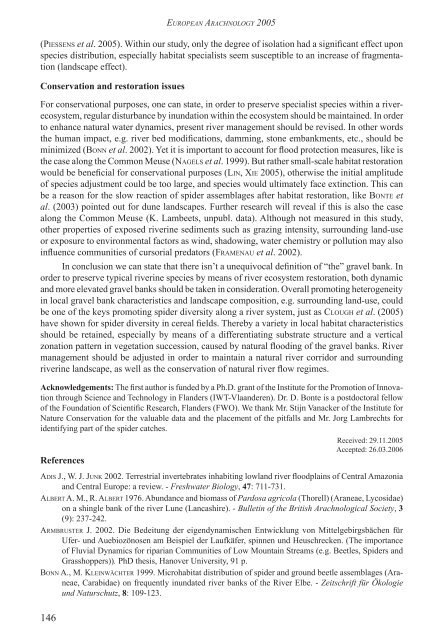(Araneae) of gravel banks and environmental constraints along a ...
(Araneae) of gravel banks and environmental constraints along a ...
(Araneae) of gravel banks and environmental constraints along a ...
You also want an ePaper? Increase the reach of your titles
YUMPU automatically turns print PDFs into web optimized ePapers that Google loves.
146<br />
EuropEan arachnology 2005<br />
(piEssEns et al. 2005). Within our study, only the degree <strong>of</strong> isolation had a significant effect upon<br />
species distribution, especially habitat specialists seem susceptible to an increase <strong>of</strong> fragmentation<br />
(l<strong>and</strong>scape effect).<br />
Conservation <strong>and</strong> restoration issues<br />
For conservational purposes, one can state, in order to preserve specialist species within a riverecosystem,<br />
regular disturbance by inundation within the ecosystem should be maintained. In order<br />
to enhance natural water dynamics, present river management should be revised. In other words<br />
the human impact, e.g. river bed modifications, damming, stone embankments, etc., should be<br />
minimized (Bonn et al. 2002). Yet it is important to account for flood protection measures, like is<br />
the case <strong>along</strong> the Common Meuse (nagEls et al. 1999). But rather small-scale habitat restoration<br />
would be beneficial for conservational purposes (lin, xiE 2005), otherwise the initial amplitude<br />
<strong>of</strong> species adjustment could be too large, <strong>and</strong> species would ultimately face extinction. This can<br />
be a reason for the slow reaction <strong>of</strong> spider assemblages after habitat restoration, like BontE et<br />
al. (2003) pointed out for dune l<strong>and</strong>scapes. Further research will reveal if this is also the case<br />
<strong>along</strong> the Common Meuse (k. Lambeets, unpubl. data). Although not measured in this study,<br />
other properties <strong>of</strong> exposed riverine sediments such as grazing intensity, surrounding l<strong>and</strong>-use<br />
or exposure to <strong>environmental</strong> factors as wind, shadowing, water chemistry or pollution may also<br />
influence communities <strong>of</strong> cursorial predators (FramEnau et al. 2002).<br />
In conclusion we can state that there isn’t a unequivocal definition <strong>of</strong> “the” <strong>gravel</strong> bank. In<br />
order to preserve typical riverine species by means <strong>of</strong> river ecosystem restoration, both dynamic<br />
<strong>and</strong> more elevated <strong>gravel</strong> <strong>banks</strong> should be taken in consideration. Overall promoting heterogeneity<br />
in local <strong>gravel</strong> bank characteristics <strong>and</strong> l<strong>and</strong>scape composition, e.g. surrounding l<strong>and</strong>-use, could<br />
be one <strong>of</strong> the keys promoting spider diversity <strong>along</strong> a river system, just as clough et al. (2005)<br />
have shown for spider diversity in cereal fields. Thereby a variety in local habitat characteristics<br />
should be retained, especially by means <strong>of</strong> a differentiating substrate structure <strong>and</strong> a vertical<br />
zonation pattern in vegetation succession, caused by natural flooding <strong>of</strong> the <strong>gravel</strong> <strong>banks</strong>. River<br />
management should be adjusted in order to maintain a natural river corridor <strong>and</strong> surrounding<br />
riverine l<strong>and</strong>scape, as well as the conservation <strong>of</strong> natural river flow regimes.<br />
Acknowledgements: The first author is funded by a Ph.D. grant <strong>of</strong> the Institute for the Promotion <strong>of</strong> Innovation<br />
through Science <strong>and</strong> Technology in Fl<strong>and</strong>ers (IWT-Vla<strong>and</strong>eren). Dr. D. Bonte is a postdoctoral fellow<br />
<strong>of</strong> the Foundation <strong>of</strong> Scientific Research, Fl<strong>and</strong>ers (FWO). We thank Mr. Stijn Vanacker <strong>of</strong> the Institute for<br />
Nature Conservation for the valuable data <strong>and</strong> the placement <strong>of</strong> the pitfalls <strong>and</strong> Mr. Jorg Lambrechts for<br />
identifying part <strong>of</strong> the spider catches.<br />
References<br />
Received: 29.11.2005<br />
Accepted: 26.03.2006<br />
adis J., W. J. Junk 2002. Terrestrial invertebrates inhabiting lowl<strong>and</strong> river floodplains <strong>of</strong> Central Amazonia<br />
<strong>and</strong> Central Europe: a review. - Freshwater Biology, 47: 711-731.<br />
alBErt A. M., R. alBErt 1976. Abundance <strong>and</strong> biomass <strong>of</strong> Pardosa agricola (Thorell) (<strong>Araneae</strong>, Lycosidae)<br />
on a shingle bank <strong>of</strong> the river Lune (Lancashire). - Bulletin <strong>of</strong> the British Arachnological Society, 3<br />
(9): 237-242.<br />
armBrustEr J. 2002. Die Bedeitung der eigendynamischen Entwicklung von Mittelgebirgsbächen für<br />
Ufer- und Auebiozönosen am Beispiel der Laufkäfer, spinnen und Heuschrecken. (The importance<br />
<strong>of</strong> Fluvial Dynamics for riparian Communities <strong>of</strong> Low Mountain Streams (e.g. Beetles, Spiders <strong>and</strong><br />
Grasshoppers)). PhD thesis, Hanover University, 91 p.<br />
Bonn A., M. klEinwächtEr 1999. Microhabitat distribution <strong>of</strong> spider <strong>and</strong> ground beetle assemblages (<strong>Araneae</strong>,<br />
Carabidae) on frequently inundated river <strong>banks</strong> <strong>of</strong> the River Elbe. - Zeitschrift für Ökologie<br />
und Naturschutz, 8: 109-123.
















